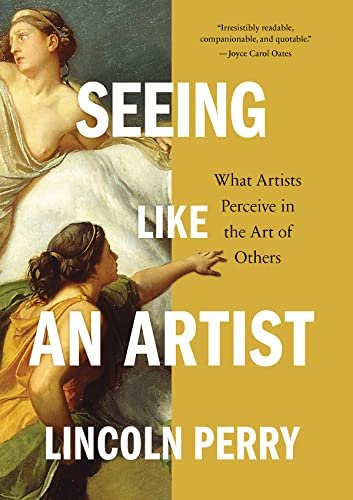Seeing Like An Artist by Lincoln Perry
/Seeing Like An Artist: What Artists Perceive in the Art of Others
By Lincoln Perry
Godine 2022
“Artists visit museums the way bears visit beehives – it’s less a genteel process than a needy, hungry grabbing at the sweetness within,” writes Lincoln Perry, himself an artist, at the beginning of his new book Seeing Like An Artist: What Artists Perceive in the Art of Others. “We circle the hive, casing the joint, sniffing, stealing what calls to us; then, our appetites temporarily sated, we return to our studio and get back to work.”
It feels communal, despite that mention of stealing, almost cuddly, which makes it darkly hilarious in its way. Most artists only visit art museums in order to attend their own shows and accept obeisance while swilling cheap champagne. If prurience or an impatient bladder compels them to wander around past other displays of contemporary art, their usual feeling is one of seething insecure contempt, the same thing that makes them hunt the obituaries for any mention of their “dear friends” and “beloved mentors.” Also, it’s worth remembering that bears destroy beehives.
But at least that opening gambit foreshadows the tone of the rest of the book. Perry takes readers through a wide selection of major works of art – not reproduced here but rather, intriguingly, drawn by Perry himself, which introduces fascinating variations that really speak to the book’s title. Regardless of anything Perry actually says about any of the artwork he discusses, his illustrations are a guided tour of how he sees these works.
Of course, the bulk of the book is full of what he says about the artwork, and these ruminations range from lazy and derivative to worldly and very interesting, sometimes in the same passage. Take as an example his discussion of Jacques-Louis David’s famous 1793 painting “The Death of Marat,” which Perry calls “a masterpiece of understatement”:
A tawny brown wood box is locked to the painting’s bottom edge … which means the note on the box casts a shadow and projects into our space, inviting us into the picture. Having entered at the box, our eye travels to the inkwell, over the jade green cloth on which the letter Corday had used to gain access to Marat rests, along the victim’s left arm to the fatal wound, down to the hand that holds the quill, and, finally, to the knife on the floor. We make a full spatial and narrative circuit beginning and ending at Marat’s simple box desk, which has now become his tombstone and is, in turn in exact proportion with the painting itself, a meta-memorial.
At what point is a passage like this not so much a thoughtful analysis but rather just a careful description? And how many of Perry’s art-snob readers would be pretentious enough to claim those two things are the same? Readers already familiar with any of the artists or works Perry discusses will find themselves asking those kinds of questions rather more often than they wish.
Good paintings, Perry writes, allow “us” to see deeper, “to sense what’s behind the walls as well as what’s on them, to be sheltered or enclosed in an imagined world the way we feel reading a favorite book.” He tells his readers they must not become “passive recipients” but instead participants in the artworks they experience. It’s stubbornly unclear how Seeing Like an Artist will help anybody do that. But watching him ransack some beehives is certainly entertaining.
Steve Donoghue is a founding editor of Open Letters Monthly. His book criticism has appeared in The Washington Post, The American Conservative, The Spectator, The Wall Street Journal, The National, and the Daily Star. He writes regularly for The Boston Globe, the Vineyard Gazette, and the Christian Science Monitor.

